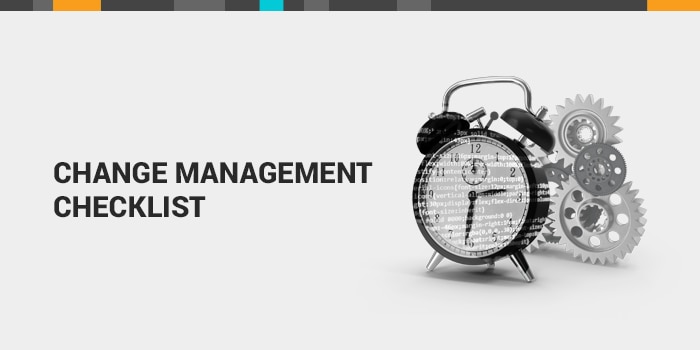Change management methodologies are often seen as complex and clunky, which can lead to these initiatives having a high failure rate in many organizations—but why does change management have this stigma?
At one point in my career, I was a regular at change advisory board (CAB) meetings and maintained our organization’s standard change catalog. What I saw was that the
changes that succeed happen within organizations that value change management as part of the process and rely on their workforce to lead these changes.
According to the Gartner report “Changing Change Management Change Management,” 80% of companies surveyed implement change management from the top down. And while 64% of employees already have the skills required to change, the report found only 25% could embrace change by altering the way they work when managed with a top-down approach.
When organizational change management is implemented correctly, change requests can be executed smoothly and the entire organization, from stakeholders to support employees, can progress through the change with little disruption to their daily work.
I want to share some change management best practices that can help your processes run smoother and drill a bit deeper into how you can enable greater buy-in across your organization. By implementing these eight change management best practices, you can help set your organization up for success.
1. Focus on Requirements and Success Criteria
When building a successful change management program, it’s essential to focus on requirements and success criteria upfront. While some organizations begin to focus on change management as part of an organizational upleveling, others begin to focus on it because of a particular event—usually a change going very wrong.
When approaching change in response to a single issue, you’re likely to end up with upset employees and disengaged stakeholders, which can make any further change attempts even less successful. This is because your employees were already annoyed by the initial change thrust upon them without any structure or why and your stakeholders are burned by the previous change being unsuccess ful. Additional changes will feel like a doomed endeavor and a waste of time.
Dissecting the requirements for a change management strategy and clearly defining success criteria up front is very important for the success of the program. It also makes it easy to show stakeholders and those involved in the project progress as the change management processes are adopted. By taking the time to define the “what” and “why” behind the change management updates, it provides employees with the reasons for and benefits of the change – leading to changes succeeding. Without employee buy-in for any organizational change, the change is unlikely to succeed.
2. Understand Risk
Understanding the risk threshold of your environment and organization is very important when getting started. In some organizations, IT professionals may not want to roll out a standard change on the most critical of applications in the environment due to the risk associated.
Knowing which systems are the most critical, and the risk to the business of these systems being disrupted, is a very important part of creating the right workflows for your change processes. By determining potential risks beforehand and gaining input from those closely involved in the business processes being changed, changes can be created together with a level of transparency that helps ensure no one is surprised by the decisions made.
3. Understand Different Types of Changes
There are a few different types of changes when it comes to IT Service Management (ITSM). IT Infrastructure Library (ITIL), an IT service management framework that outlines best practices for delivering IT services, specifically focuses on three types of changes:
- Standard Changes: These changes are pre-authorized in an environment via a standard change catalog, do not require a trip to the CAB and are classified as low risk.
- Emergency Changes: These require an immediate change implementation, usually to address some sort of incident in the environment with a high risk associated.
- Normal Changes: These are changes that don’t fall into the first two categories. It’s where things start to get interesting.
Normal changes are usually classified as Major, Significant, or Minor. They require different levels of approval, based on the change management processes in place and the risk associated with the change.
4. Train Your Teams
Once baselines of the change program are established, it’s essential to train everyone in the organization: those sitting on the CAB, those acting as change managers, and those creating and implementing Requests for Change (RFC).
In some cases, it can be valuable to bring in a third-party ese types of training activities, providing another point of view to team members. Many firms have change managers who can strategize the most effective way to roll out training to get the most buy-in. Without buy-in, change management initiatives often have a very slim chance of being successful.
5. Keep It Simple
It’s important to keep things simple. Everyone in the organization should have a good understanding of the types of changes in the environment and what is required of them as part of change efforts. If employees do not feel included or considered when implementing a change initiative, they are more likely to push against the change.
The change management processes from creating RFCs to going to the CAB should also be simple for those who need to create and implement changes. A little bit of simplicity goes a long way for the health of the change management program overall.
6. Communication Is Key
Communication is key for everyone involved in every change. There’s nothing more frustrating than trying to prepare for a change when you don’t know if it will be approved in time. It’s important to keep everyone in the loop, from those requesting changes to business owners, and having a communication plan in place can help keep everything running smoothly.
7. Document Everything
Everything should be documented when it comes to driving effective change management. It’s important to make sure there’s a trail from the standard change catalog, to records of standard changes, to RFCs, to the process they go through for approval. There’s no such thing as too much documentation in this case.
Organizations often go down the path of change management because something terrible happened in the environment. That highlights the need to quickly and easily be able to see what changes were made, and when. Likewise, when a change initiative is successful, documentation of the process can inform future changes and serve as a change management model to build from.
8. Automate Processes When Possible
Many ITSM processes can be automated, and they should be, whenever possible. There’s tremendous value in a change entering into an automated process when it’s created, as it streamlines the change management process for everyone involved.
I can’t tell you how many times I’ve been at a CAB meeting where someone didn’t have the information they needed to make a decision. Automation can ensure all stakeholders, such as CAB members and change managers, have all the necessary information and metrics at their fingertips, whenever they need it.
What is the Best Approach For Implementing Change Management?
Change management is essential for any IT organization and even more critical when implementing changes within an IT environment, as these failures can have costly and damaging consequences. While it gets a bad reputation for being difficult to manage and follow, many times the reason why change management isn’t successful is due to a lack of transparency and upfront planning with the right stakeholders.
Bottom line: If change management isn’t properly implemented, the changes will fail. With any new project, taking your time and considering all viewpoints can provide the greatest chance of success. Using these change management best practices can also help simplify implementation and make things run much smoother.
No matter where you are on the ITSM path,
SolarWinds® Service Desk is built to help streamline and automate many ITSM implementation tasks as you follow these
change management best practices.







